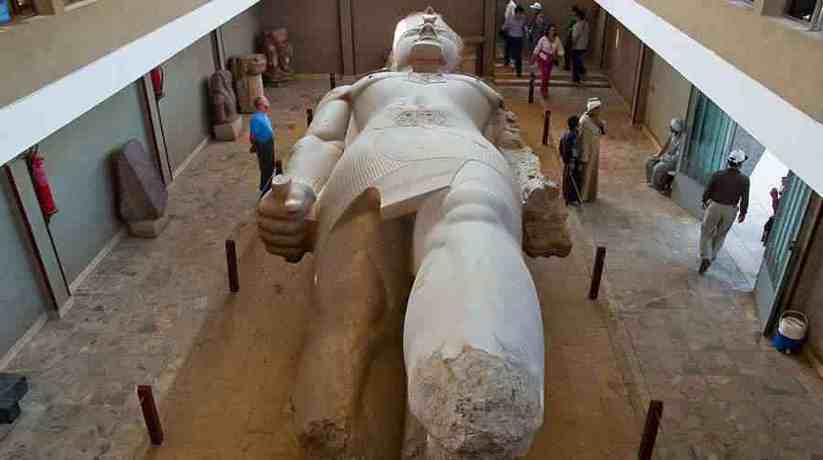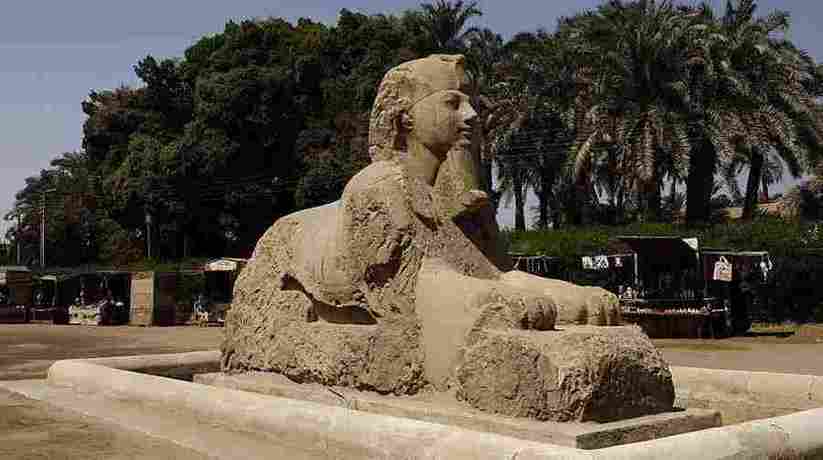Memphis Cairo Egypt information, tours, prices, booking
Memphis Cairo Egypt was a city and the capital of Ancient Egypt. It indeed was an important center during much of Egyptian history. Memphis Cairo located south of the Nile River delta. It is on the west bank of the river. The site is about 15 miles (24 km) south of modern Cairo. Moreover, its archaeological zone designated a UNESCO World Heritage site in 1979. It founded about 2925 BC by Menes. Menes united the two prehistoric kingdoms of Upper and Lower Egypt. The original name of the city was the White Walls. The modern name of Memphis is a Greek version of the Egyptian Men-Nefer. This name is of the nearby pyramid king Pepi I.
Ptah was the local god of Memphis Cairo. He was a patron of craftsmen and artisans. Furthermore, he was also a creator god. The great temple of Ptah was one of the city’s most prominent structures. He created humans through the power of his heart and speech. Memphis Cairo reached preeminence by the third dynasty. The huge royal pyramid tombs of this period in the necropolises of Memphis indeed confirm this. Djoser was the second king of the third dynasty. He also was the builder of the Step Pyramid in Sakkara. Sakkara is the earliest royal foundation at the site. Moreover, it is also the first important stone building in Egypt.
Further details about Memphis Cairo Egypt:
Imhotep was the king’s architect and adviser. He credited with this architectural feat. He also was wise man and physician. His reputation led to his deification and his identification with the Greek god Asclepius. There are remains of several unfinished or ruined pyramids near Memphis Cairo. They have attributed to other 3rd dynasty kings. The first king of the 4th dynasty was Snefru. He built two pyramid tombs at Dahshur. The last known king of this dynasty was Shepseskaf. He built his tomb at south Sakkara. In fact, it was not a pyramid but a distinctive oblong structure with sloping sides.
In fact, the royal pyramids surrounded by large cemeteries. They are where the courtiers and officials who had served the king during his lifetime buried. The beautiful reliefs in certain of these tombs include scenes of daily life. Thus it gives some idea of the crafts, costumes, and occupations of the royal court of Memphis. These reliefs are a valuable source of information on such subjects. An exception to the general rule of loss and destruction which is the hidden tomb of Queen Hetepheres. She was the mother of Khufu. Her tomb discovered near the Great Pyramid of Giza. Though the queen’s body was missing from her sarcophagus. Moreover, Her funerary equipment and furniture survived.
More details about Memphis Cairo Egypt:
In fact, some scholars believe that Old Kingdom influenced by the craftsmen of the Memphis Cairo court. The kings of the 5th dynasty (2465 BC – 2325 BC) moved south of Giza to build their funerary monuments. The pyramid temples and causeways decorated with fine reliefs. This dynasty marked by a decline of Memphis influence. It paralleling the rise of a sun cult centered at Heliopolis. The major monuments of the period are not the pyramids but the sun temples. The pyramid field of Sakkara continued to decline in size and workmanship. It was during the 6th dynasty.
At that time the influence of the centralized government at Memphis Cairo began to wane. It indicated by the increased prominence of provincial cities. It was also by the number of fine tombs which located away from the Memphis Cairo area. This process of decentralization ended in the First Intermediate Period. Another period of political and social chaos followed the 13th dynasty. Second Intermediate Period characterized by the presence in Egypt of the Asian Hyksos peoples. The Hyksos king, whom he calls Salitis made his capital at Memphis. From there, he ruled both Upper and Lower Egypt. But his capital generally supposed to locate at Avaris, near Tanis, in the Nile delta.
Further details about Memphis Cairo Egypt:
The importance of Memphis Cairo Egypt based to an extent on its venerable religious role. Certain of the coronation ceremonies enacted in the site. The Heb-Sed festival is a jubilee which celebrated by the king after 30 years of rule. It repeated every three years thereafter. Perhaps it was a ritual reenactment of the unification of Egypt. During the New Kingdom, Memphis functioned as the second, or northern, capital of Egypt. At one time it seemed to have been the principal residence of the crown prince. Several 18th-dynasty inscriptions mention royal hunting parties in the desert near the Sphinx. Amenhotep II born at Memphis Cairo. He held the office of high priest there. Both he and his son, Thutmose IV reigned 1400–1390 BC. He left inscriptions at Giza.
Despite the rise of the god Amon of Thebes, Ptah remained one of the principal gods of the pantheon. The great temple of Ptah added to or rebuilt by every king of the 18th dynasty. Chapels constructed by Thutmose I, Thutmose IV and Amenhotep III. Amenhotep III’s son was the religious reformer Akhenaton. He built a temple to his god, Aton, in Memphis Cairo. There are many tombs dating back to this period in the Memphis Cairo necropolis. They testify to the existence of a sizable court. During the New Kingdom Memphis shared the cosmopolitan character of the nation. It shared as trade, foreign conquest and travel developed. Though Memphis Cairo was not on the Nile. It connected with the Nile by a canal and it was important as a commercial center.
More details about Memphis Cairo Egypt:
In fact, Specific quarters of Memphis city named for the foreign colonies who resided there. They were like slaves, prisoners of war, or merchants. Under the 19th dynasty, a new royal house built farther north at Per Ramessu in the delta. But Memphis Cairo continued to be important. The great temple of Ptah rebuilt. The kings of that period pillaged the monuments of their predecessors for building materials. Furthermore, Some of the reused blocks come from Memphis necropolises. Ramses II who reigned from 1279–13 BC, erected several colossi in the temple. The Serapeum dedicated to the cult of Apis, the bull-god. It built in the form of a labyrinth. It begun under the son of Ramses II, Khaemwese, high priest of Ptah.
By the end of the 20th dynasty (1190–1075 BC) the united kingdom had begun to break down once again. The official capitals were Tanis and Thebes. But the royal palace at Memphis Cairo also continued to mentioned. The growing popularity of the Apis cult led to further enlargement of the Serapeum. In addition, in the 8th century BC, the Nubian king Piye conquered Egypt and restored its unity. Nubia (Kush) is to the south of Egypt. It had been under Egyptian political and cultural influence for centuries.
Further details about Memphis Cairo Egypt:
An inscription describing Piye’s campaign has survived, and it mentions a siege of Memphis Cairo. The city had fortified walls and surrounded by water, presumably from its encircling canals. Piye took the city, but it left to his brother and successor, Shabaka, to claim the royal title. There are some indications that this king made Memphis his capital. But the Kushite dynasty overthrown shortly thereafter. In fact, it was when the Assyrians invaded Egypt.
The siege and destruction of Memphis Cairo Egypt was because of the royal house of one Tarku (Taharqa). He was the king of Egypt. In addition, he became pharaoh in 690 BC. Taharqa regained Memphis, but he driven out of the city again by Ashurbanipal of Assyria. It was in 667/668 BC. The collapse of Assyria (612 BC) led to brief Egyptian independence. It was under the 26th dynasty. But in fact, it was not long before new invaders appeared. The Persian Cambyses II took Memphis by siege in 525 BC. After years of Persian rule, Egypt was ready to welcome Alexander the Great in 332 BC. The conqueror used Memphis as his headquarters. It was while making plans for his new city of Alexandria. After his death at Babylon, his body brought to Egypt. He laid to rest in Memphis Cairo before buried at Alexandria.
More details about Memphis Cairo Egypt:
Under the Hellenistic Ptolemaic dynasty (332–30 BC), Memphis Cairo retained its cosmopolitan character. It had a sizable Greek population. Some of the diversified racial types to found in the city during Greco-Roman times. They depicted in a series of striking terra-cotta heads dating from this period. At the beginning of the Roman period, Memphis was still an important provincial capital. The serious decay of the ancient city began after the rise of Christianity. In brief, it was when zealots of that faith defaced and destroyed the remaining pagan temples.
Additionally, the Christian monastery of Apa Jeremias rose among the venerable tombs of Sakkara. It was in the 5th century. Therefore, the capital continued to deteriorate. It was receiving its death blow during the Muslim conquest of Egypt in 640 AC. Furthermore, a garrison and fort called Babylon occupied the eastern end of the bridge. This bridge crossed the Nile from Memphis. After a long siege the fortress taken by the Arab general Amr ibn Al Aas.
Further details about Memphis Cairo Egypt:
Memphis Cairo Egypt abandoned, and later the few remaining structures dismantled. So that the stone maybe reused in the neighboring villages and in Cairo. It was after that city’s founding in the 10th century. The ancient city of Memphis Cairo lies near the modern village of Mit Ruhaynah. At the beginning of the 20th century some ruined walls still seen. The only monument above ground is a colossal statue of Ramses II. It was once adorned the great temple of Ptah.
















